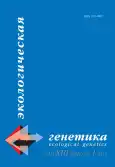Новые штаммы дрожжей pichia pastoris - продуценты гетерологичных белков
- Авторы: Музаев Д.М.1, Румянцев А.М.1, Самбук Е.В.1, Падкина М.В.1
-
Учреждения:
- Санкт-Петербургский государственный университет
- Выпуск: Том 13, № 1 (2015)
- Страницы: 10-15
- Раздел: Статьи
- URL: https://journals.rcsi.science/ecolgenet/article/view/2401
- DOI: https://doi.org/10.17816/ecogen13110-15
- ID: 2401
Цитировать
Полный текст
Аннотация
Ключевые слова
Полный текст
Открыть статью на сайте журналаОб авторах
Дмитрий Михайлович Музаев
Санкт-Петербургский государственный университет
Email: dmmuzaev@yandex.ru
магистр, кафедра генетики и биотехнологии
Андрей Михайлович Румянцев
Санкт-Петербургский государственный университет
Email: rumyantsev-am@mail.ru
магистр, кафедра генетики и биотехнологии
Елена Викторовна Самбук
Санкт-Петербургский государственный университет
Email: esambuk@mail.ru
д. б. н., профессор, кафедра генетики и биотехнологии
Марина Владимировна Падкина
Санкт-Петербургский государственный университет
Email: mpadkina@mail.ru
д. б. н., профессор, кафедра генетики и биотехнологии
Список литературы
- Brierley R. A. (1998) Secretion of recombinant human insulin-like growth factor (IGF-1). Methods in Molecular Biology: Pichia Protocols, Humana Press, Totowa, NJ. V. 103: P. 149-177.
- Cregg J. M., Cereghino J. L., Shi J. Y., Higgins D. R. (2000) Recombinant protein expression in Pichia pastoris. Mol Biotechnol. V. 16: P. 23-52.
- Darby R. A., Cartwright S. P., Dilworth M. V., Bill R. M. (2012) Yeast Species Shall I Choose? Saccharomyces cerevisiae Versus Pichia pastoris (Review). Recombinant Protein Production in Yeast: Methods and Protocols, Methods in Molecular Biology. V. 866: P. 11-23.
- Guthrie C., Fink G. R. (1991) Guide to yeast genetics and molecular biology. Academic Press. V. 3: P. 194-933.
- Higgins D. R., Busser K., Comiskey J., Whittier P. S., Purcell T. J., Hoeffler J. P. (1998) Small vectors for expression based on dominant drug resistance with direct multicopy selection. Methods in Molecular Biology: Pichia Protocols, Humana Press, Totowa, NJ. V. 103: P. 41-53.
- Littlewood B. S. (1972) A method for obtaining antibiotic-sensitive mutants in Saccharomyces cerevisiae. Genetics. V. 71 (2): P. 305-308.
- Scorer C. A., Clare J. J., McCombie W. R., Romanos M. A., Sreekrishna K. (1994) Rapid selection using G418 of high copy number transformants of Pichia pastoris for high-level foreign gene expression. BioTechnology. V. 12: P. 181-184.
- Sambrook J., Russel D. W. (2001) Molecular cloning: A laboratory manual, 3d edition. New York: Cold Spring Harbour Laboratory Press.
- Sherman F. (1997) Yeast genetics. The encyclopedia of molecular biology and molecular medicine. V. 6: P. 302-325.
- Sunga A. J., Cregg J. M. (2004) The Pichia pastoris formaldehyde dehydrogenase gene (FLD1) as a marker for selection of multicopy expression strains of P. pastoris. Gene. V. 330: P. 39-47.
- GenBank. Komagataella pastoris GS115. Reference genome sequence. Cited 19.12.2014. URL: http://www.ncbi.nlm.nih.gov/genome/338?genome_assembly_id=28698.
- Pichia pastoris Genome Browser. Genome Database of the Pichia pastoris. Cited 19.12.2014. URL: http://www.pichiagenome.org/.
- Lin Cereghino G. P., Lin Cereghino J., Sunga A. J., Johnson M. A., Lima M., Gleeson M. A. G., Cregg J. M. (2000) New selectable marker/auxotrophic host strain combinations for molecular genetic manipulation of Pichia pastoris. Gene. V. 263: P. 159-169.
- Scherer S., Davis R. W. (1979) Replacement of chromosome segments with altered DNA sequences constructed in vitro. Proc. Natl. Acad. Sci. V. 76: P. 4951-4955.
Дополнительные файлы






